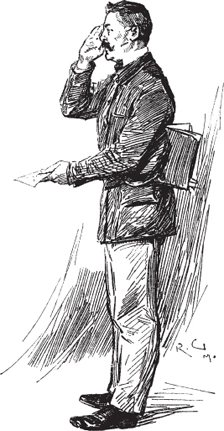The question was how to identify an unknown prisoner. I could have done it in twenty-four hours. Lecoq took six months or so. It might be made a text-book for detectives to teach them what to avoid.”86
I felt rather indignant at having two characters whom I had admired treated in this cavalier style. I walked over to the window and stood looking out into the busy street. “This fellow may be very clever,” I said to myself, “but he is certainly very conceited.”
“There are no crimes and no criminals in these days,”87 he said, querulously. “What is the use of having brains in our profession? I know well that I have it in me to make my name famous. No man lives or has ever lived who has brought the same amount of study and of natural talent to the detection of crime which I have done. And what is the result? There is no crime to detect, or, at most, some bungling villainy with a motive so transparent that even a Scotland Yard88 official can see through it.”
I was still annoyed at his bumptious style of conversation. I thought it best to change the topic.
“I wonder what that fellow is looking for?” I asked, pointing to a stalwart, plainly dressed individual who was walking slowly down the other side of the street, looking anxiously at the numbers. He had a large blue envelope in his hand, and was evidently the bearer of a message.
“You mean the retired sergeant of Marines,” said Sherlock Holmes.
“Brag and bounce!” thought I to myself. “He knows that I cannot verify his guess.”
The thought had hardly passed through my mind when the man whom we were watching caught sight of the number on our door, and ran rapidly across the roadway. We heard a loud knock, a deep voice below, and heavy steps ascending the stair.

“ ‘For Mr. Sherlock Holmes,’ he said.”
Richard Gutschmidt, Späte Rache (Stuttgart: Robert Lutz Verlag, 1902)
“For Mr. Sherlock Holmes,” he said, stepping into the room and handing my friend the letter.
Here was an opportunity of taking the conceit out of him. He little thought of this when he made that random shot. “May I ask, my lad,” I said, in the blandest voice, “what your trade may be?”
“Commissionaire, sir,” he said, gruffly. “Uniform away for repairs.”
“And you were?” I asked, with a slightly malicious glance at my companion.
“A sergeant, sir, Royal Marine Light Infantry,89 sir. No answer? Right, sir.”
He clicked his heels together, raised his hand in salute, and was gone.
50 Many U.S. editions omit the “B.”
51 See this editor’s “Layout of a ‘Most Desirable Residence’ “ for a discussion of the room arrangement and furnishings.
52 After researching reasonable rents of the time, Michael Harrison estimates, in In the Footsteps of Sherlock Holmes, that Holmes and Watson likely paid an “all-in” rent of between £3 and £4 a week. This would have included laundry and food but probably did not cover gas, which “may explain the references, frequent throughout Watson’s writings, to the oil-lamps at 221B.”
53 In Chapter I, Watson advised Holmes that he got up “at all sorts of ungodly hours.” But in “The Speckled Band,” Holmes is described by Watson as “a late riser as a rule,” and Watson describes himself as “regular in my habits.” A similar depiction crops up in The Hound of the Baskervilles (see note 2 and accompanying text), with Watson recounting that Holmes “was usually very late in the mornings.” At the very least, Holmes’s habits seem variable; “The Engineer’s Thumb” finds Watson expecting to encounter Holmes at breakfast soon after 7:00 A.M. The only consistent pattern suggested is that Watson must have regularly arisen very late, as confirmed by his late breakfast in “The Boscombe Valley Mystery.”
54 William Baring-Gould gathers that these “long walks” must have been case-related, as Holmes was “a man who seldom took exercise for exercise’s sake” (“The Yellow Face”).
The term “low,” W. E. Edwards explains, “was a characteristic Victorian epithet to express contempt. There was a good deal of class hatred in the term ‘lower-class,’ its polite version being ‘working-class.’ ” In the Victorian era, industrialisation saw a rapid expansion of the “middle class”: shopkeepers, merchants, clerks, teachers, doctors, and lawyers; or, in other words, those who employed servants yet did not belong to the aristocracy. Those in this new middle class (whose members would have counted Holmes and Watson), who aspired to upward mobility and yet were desperate not to slip backward in status, sought to distance themselves from the working class of street vendors, miners, servants, ironworkers, and most factory workers. In 1909, the English politician C.F.G. Masterman astutely remarked that “The Rich despise the Working People, the Middle Classes fear them.”
55 In fact, it is later evident to Dr. Watson that Holmes is a regular user of cocaine (a seven-per-cent solution), and he undertakes to wean him from the drug. His use of cocaine is explicitly mentioned in “The Five Orange Pips,” “A Scandal in Bohemia,” The Sign of Four, “The Man with the Twisted Lip,” and “The Yellow Face,” and in The Sign of Four, Watson implies that Holmes has also been taking morphine. In “A Scandal in Bohemia,” Watson describes Holmes as alternating between the “drowsiness” of the drug and “the fierce energy of his own keen nature.” In “The Five Orange Pips,” Watson accused Holmes of being a “self-posioner,” and in The Sign of Four, Holmes admitted that the influence of the drug “is physically a bad one.” He defended his use on the basis that “I find it, however, so transcendently stimulating and clarifying to the mind that its secondary action is a matter of small moment.”
William S.
1 comment